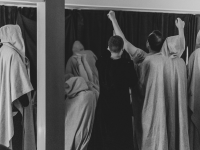A recent article entitled “Against Design” (Nordwall and Widing 2024), republished here from this year’s Solmukohta book Liminal Encounters (Kangas, Arjoranta, and Kevätkoski eds. 2024), was the inspiration and provocation for this article, and whilst naturally I thank its authors for their frank and lively debate, I have to resoundingly disagree with just about everything said in it.
Naturally, I would encourage you, my dear reader, to give it a read here, and then perhaps come back to read the thoughts of one who proudly claims the mantle of “designer”.
Firstly, my most important point: designers are not the enemies of artists. In fact, I would go a step further, and say that there is no real line between designers and artists, which is one of the things I most profoundly dislike about the article. No person, filled with the spirit of the muses, is sitting in a pine forest somewhere, hewing larps from great pieces of monolithic marble. Every person who writes, weaves, conspires, or conceives of larps is doing so considering their audience, to the materials, the spaces, the minds, and to the resources they have available to them. Whether it be decisions about communicating the message of a larp, the ways it is expected to be run, or even (and hopefully so) the ways to keep their participants safe and happy.
We create larps for human beings, real people who dwell on this earth with fears, and delights, and backstories, and jobs, and houses, and a preciously limited time to share with us. So the thought that “design”, spat out as a dirty word, as the antithesis of art, as the enemy of the artist, is in any way a bad thing, quite frankly baffles me. It would baffle me in just about any medium, be it painting, or cinema, or music, but most profoundly does it baffle me in larp.
Because unlike all those other mediums, larp is entirely unique. I might ask the philosophers to leave the room for a moment while I say this: a sculpture remains sculpted even when no one is looking at it, paintings do not cease to be when the gallery closes for the night, the cellulose in a film doesn’t melt if it hasn’t been watched in a decade, and the air still bends to the plucking of a violin even if that air should touch no person’s ears.
But a larp? A larp as a medium, as an artform, only exists, and can only exist, in the fleeting moments amongst a group of people, playing it, living it, creating it, in real-time, and only for as long as those people are there and building that story together. You can write the most fantastically beautiful, upliftingly soul-wrenching larp that has ever been conceived, but unlike a painting that may well be considered complete at the final stroke of the artist’s brush, a larp is not complete until the last word passes a player’s lips, until the last breath of someone, inhabiting the life of another, is taken.
I’m sure some may argue over whether trees falling in the forest make a sound, (and perhaps by some assessments as a mere “designer” I could be seen as unfit to have those discussions). But regardless, for now I believe it can stand without question that a larp is nothing without its players, and that we have in this medium of ours possibly the most collaborative, the most actively participatory medium that has ever been devised.
And I’d reckon that the authors of the article would agree with me, at least in broad principle, and they seem immensely passionate about protecting what they see as this special and unique medium. They might wish to hide it away, shelter it from the corrupting influences of capitalism, of commercialisation, keep it sacred, tucked away in the hills, whispered of only from the lips of ordained monks raised from birth to know the meaning of “true larp”.
But alas, I don’t live in those hills, I live in capitalism, I live in commercialisation, I live in a society, with grit under my nails, a cheap keyboard at my finger-tips, and smog in my lungs. And don’t get me wrong, sometimes I dream of running off to those forgotten places of the Earth and rejecting the modern world and all its trappings. If I didn’t need the medicine that this modern world creates to even stay alive, maybe I would’ve done so already. But for now, I still live amidst the concrete, where money talks, and the traditional ways of living have been gutted by the gods of industry.
And so when I can, I escape. I escape into TV, I escape into video games, I escape into movies, and even on occasions I have the brain space to escape into a book. I don’t think that’s too rare, all in all. But when I am escaping, sometimes I feel like I want to escape just a little bit more, y’know? To push that boundary just a smidge further, to immerse myself just a little bit more, in another life, in another place, in another reality…
And on occasions, I do.
Me and a group of my friends will get together in some field somewhere, or a scout hall, or some community centre, and dressed in cheap costumes, maybe a prop or two, and some garishly written characters, and together, we escape. And in those times, I am very glad that somebody was being a designer, because unfortunately I don’t come from a country with centuries of tradition in collaborative storytelling, at least not any that survived the Industrial Revolution. I didn’t have the opportunity to immerse myself in this artform from childhood. I don’t even generally have the luxury of knowing half the people I am playing with most of the time.
In the article, the authors make a reference to the Norwegian term for larp creating, lage, meaning ‘to make’, and reference it being the same word as used for when one makes soup. Now I realize at this point I am committing the sin of media analysis and introducing a food metaphor, but I hope you’ll forgive me. But it does seem as though the authors feel that everyone should only be eating soup. A carefully crafted, small home-cooked larp soup, made from fresh home-grown ingredients, lovingly cultivated in some little farm somewhere.
And I’ll be honest, that sounds delicious. But I don’t have a little farm somewhere; I live on a council estate in Manchester. My food comes in packets and tins, and sure, I could maybe spend lots of money on trekking out to produce markets, and then lots more time on making a beautiful fresh soup every day, and sometimes I do. But I can’t do that most of the time. To do so is a privilege that I, and most of the people I know, are not afforded. And so, when I am tired from work, when I am poor, when I am lonely, and when I am above all else: hungry, I’ll go get a burger.
And that’s what we designers are: we’re burger-flippers. We make things people can get easily, as cheaply as possible, have a good time doing it, and get value for their money. And sure, it ain’t the healthiest, it ain’t the best for us, hell it ain’t even probably the cheapest most of the time. But it’s meeting people where they’re at. Because far too many people I know are tired, poor, lonely, and hungry for a bit of respite from this world that was built around us.
So we design mechanics that allow people to jump into games without weeks of prep. We write games based on popular properties so that everyone has a baseline understanding of tone and content. We build safety systems so people can feel alright having deep personal conversations with strangers. We craft experiences that can run and give people an immersion in someone else’s world for a little while. We flip burgers. We “design”.
And when it comes to making larps that can run, I think it’s about time we talked about the elephant in the room: selling tickets. It’s a dirty business, I’d reckon there’s no larp writer in the world who really likes it, but we have to face the facts. People only have so much money, they only have so many days off work, they only have so much time they can take away from children and pets and families, they only have so much energy at the end of the working week. And larps cost money.
You combine these two facts, what do you get? The nemesis of my existence, the boss-fight at the end of every larp development process, the big bad horrible beast: the break-even number. How many tickets do I have to sell to cover my budget? How many butts in seats do I have to reach to allow this project to be a reality? Now you can have all the artistic craft in the world, you could craft the most effervescently perfect creation in larping history, but if you don’t get the people, you ain’t got nothing.
And so I do marketing. In the first few months of a larp’s creation, I’m not writing characters or doing world building or thinking up mechanics, no. I’m building a website, I’m calculating budgets, I’m pricing up venues, I’m designing graphics, and I’m figuring out how to say to people, “Hey, this is a cool larp that you should come to.” And I hate it, oh boy do I hate it, and I reckon the authors of that article hate it too, if they’ve ever done it.
So what’s the solution? Well I could just stop. I could never build another website, never create one more fancy graphic, put Facebook away, and just whisper the existence of my purely crafted larp into the breeze. Cool, well now I have a larp with no players, which as we’ve said before is less than worthless.
Alright, so we’ll appeal to the hearts of our players, implore them to stop being so picky. Why do you have to be so demanding? Just sign up to every larp you hear about, go to them all, give us all your money! Now wouldn’t that be nice, but I won’t belabour the point, it’s not really feasible, is it.
So what do we do?
Well the authors of that article have a suggestion: “stop designing”. Stop making larps that haven’t been grown organically in the forests by sustainable larping communes with at least forty years of pedigree and blessed by Idunn herself. Retreat into the wilderness and just, please, stop making larps for people. Well, I’d say that’s just about as impractical as the previous two.
Now, as said, I would love to go live in a forest for the rest of my life, with a small group of fellow larpers who I’ve known for decades and only create and share together, and let the rest of the world go kick rocks. But unfortunately for me, I was born in a failed industrial town where the smog is baked into the bricks, and where that was never really an option for me. My culture has a vibrant tradition of storytelling, mostly through song, and I am very proud that I get to carry it on into the future, and do genuine work in preserving and sharing it.
Because contrary to the implication of the article there, we aren’t all godless barbarians in these cities, we aren’t all traditionless, religionless heathens bashing rocks together for entertainment. We have a culture, we have a history, and we want to share that. And part of the way we share that is through larp.
This is very much close to my heart, as the sort of larps that I predominantly write are historical and theological larps, where I try and give people an opportunity to experience the lives and the beliefs of those that came before us. I feel it’s essential to understanding yourself and your world to be able to relate on a personal level to the lives of others, be that others who live with us now, or others who lived in the past. And larp is of course an unsurpassed tool for this, to allow someone to immerse themselves in the feelings, the life of another person. If that isn’t art, then I don’t quite know what is.
And even if we’re not making the world a more harmonious place, even if we’re not giving people the opportunity to develop empathy and all we’re doing is giving people an escape: that’s okay too. I am so proud to see this medium of ours grow ever larger. It fills me with such profound joy at every event we run where there is someone who hasn’t larped before and gets to take their first steps into this brilliant community. And I love it even more when those people get a chance to contribute to the story, to bring in their experiences and their knowledge and their feelings and ideas.
In the article, the authors accuse design of stifling innovation. They claim that designing one’s larps and focussing on the experience of participants leads to stagnation and intellectual decline. And I again, frankly, could not disagree more. Design lowers the bar to entry, it brings people in, from more places, from more backgrounds, from more peoples, and from more cultures. And that is how you innovate. By offering more people a seat at the table, from learning, and growing, and sharing, and mixing, and giving everyone you possibly can a voice to contribute and create something beautiful.
We have in our hands an artform that is unique, because it relies on the hands, the hearts, the voices, and the souls of everyone in the audience to make it what it is. Not only to experience it, but to craft it along with us. Most of the people I play larps with or make larps for wouldn’t consider themselves artists, and yet that’s entirely what they are. And so are we, the designers. Because we are making art, by getting people there, by giving them the tools to engage with the game, to play with other people, to feel safe and supported and free to create according to where they are at. If a larp is an artistic medium, then making a larp happen is art, designing a larp is artistic.
And I shall come at last to the final paragraph of that article, in the penultimate of my own. Therein they say, “Larps can happen through community building, collaborative creation, or even serendipity.” And in this I agree, larp and collaborative experience-centred design can come from anywhere. But I am led to another quote I once heard, by Plutarch, saying, ”No man ever wetted clay and then left it, as though there would be bricks by chance and fortune.”
Well, I and my fellow designers aren’t gonna just wait around for larps to pop out of the ground, or be handed to us on gilded tablets by our Scandinavian cousins. We are the brick-makers, and we are working very hard, with the clay we have, to build a community of wonderful players and incredible experiences, out of those bricks.
Cover image: Photo by yazriltri on Pixabay.






